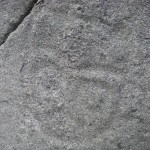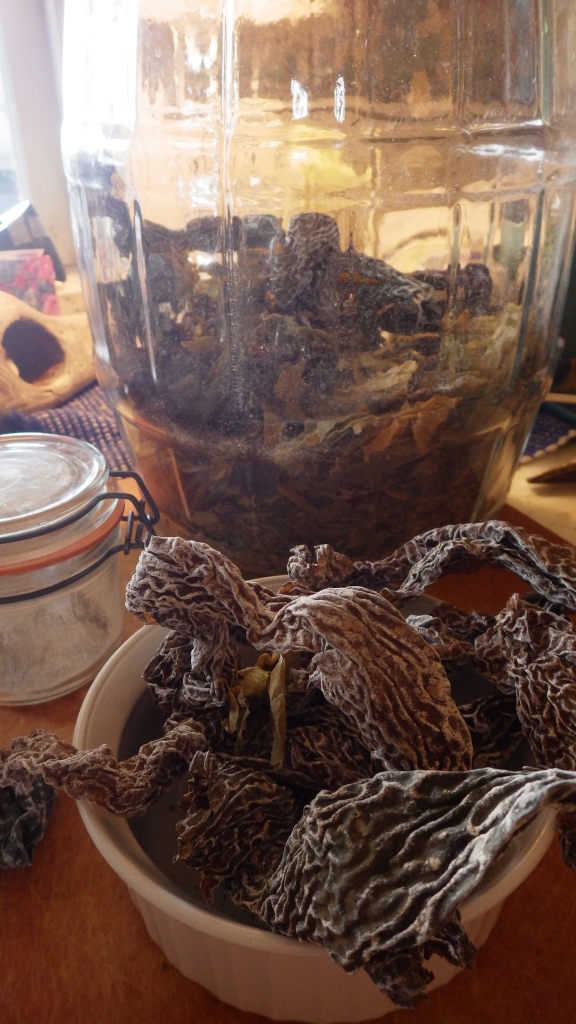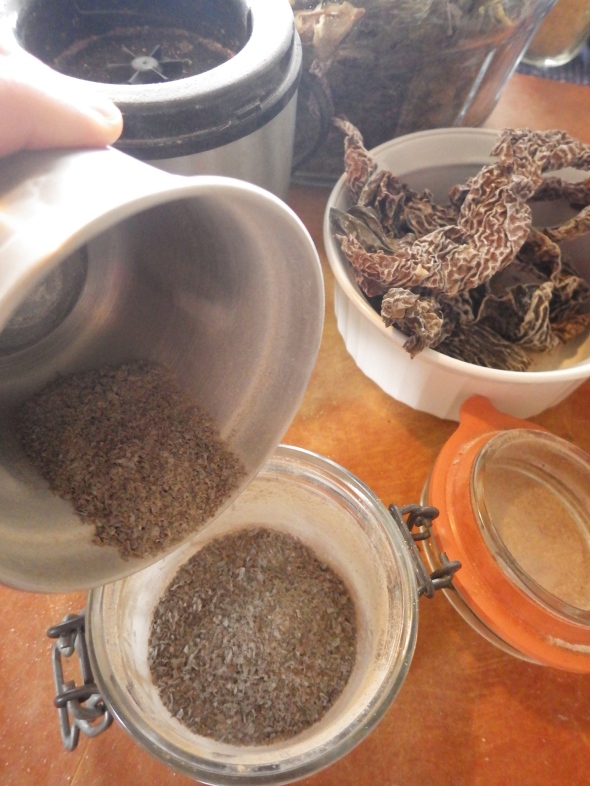Giant Seaweed meets the Kitchen (updated)


- Sea Soup….think seaweed and salmon and sea asparagus and chanterelle mushrooms and pine mushrooms simmered in a slow cooker all day, or better yet over the fire on a west coast beach! Unfortunately I haven’t been able to find all ingredients at precisely the same time … So it all needs to be caught and gathered and processed for later use.
The ocean offers everything, even a Japanese glass float after the storm.
Giant Kelp or Macrocystis is a brown, canopy growing seaweed that can reach lengths of 100 feet. The blades are wrinkled and each blade has a gas filled bladder attached to the main stalk. Interesting to note about seaweed is that there are three main groups: green, red, and brown and each group grow at differing water depths.
Tolerance to stress such as wave action, substrate attachment, and exposure to air is indicated with different seaweed groups growing in a vertical striation along the shore. The line of growth of red, green, and brown kelp is most noticeable on an extremely lower, low tide meaning the time when the tidal range is at its extreme lowest. In addition this mosaic of color is most noticeable on bedrock beaches because the seaweed holdfasts have a solid substrate to grow on.
Giant Kelp or Macrocystis is distributed in the lower intertidal and the Subtidal zone, the zone below the extreme lower, low, water and the Subtidal, the area below the lowest intertidal and the area exposed to little or no air (Lindeberg&Linstrom, 2010). It is distributed from Alaska to Mexico. There is two different species indicated by their holdfast. As you can envision the deep water (lower subtidal) growing species, Macrocystis pyrifera needs more arms to hold to substrate in deep, ocean wave habitat. Often after a storm their hand size holdfast can be found washed up on the shore, a brown-red clump, a mass of interwoven threads.
Macrocystis pyrifera is distributed from Monterey to Mexico, but it is known to grow in certain areas of B.C and Alaska. The species Macrocystis integrifolia inhabits the northern region where it grows in the lower intertidal and upper subtidal (Druehl, 2007).
Macrocystis is “the largest of all seaweeds” (Druehl, 2007. Pg.93) and when dried and finely ground and cooked alone or with other food, is a great addition to every meal.
Note: Another brown seaweed much easier to collect especially on your walk along the shore at low tide is the brown seaweed, Rockweed or pop weed, Fucus distichus.
Remember: Brown seaweeds need to be cooked. Sprinkle food with brown seaweed flakes before popping in the oven. Or cook separately-Seaweed and water-boil and simmer, make a paste and use as a topping.
References:
Druehl, L. 2007. Pacific Seaweeds, A guide to common seaweeds of the West Coast. Harbour Publishing. B.C.
Lindberg,M .& Lindstrom,S. 2010. Field Guide to Seaweeds of Alaska. Published by Alaska Sea Grant Program, University of Alaska. Fairbanks.

Here is an interesting example of a seaweed holdfast clinging to a scallop shell though not sure what type of seaweed it belongs to.
Here is another type of seaweed called sugar kelp, a very thin bladed kelp easy to break up when dry, unlike the Giant kelp which is tough and leathery. Here it is drying on a summer day in the boat.

more…… seaweed drying…..

A brown seaweed ; Sugar Kelp drying.

Macrocystis dries to a very tough leather, so it needs to be ground up to be palatable. A cuisinart spice and nut grinder works well to blend it into fine flakes.

Macrocystis ready to grind up in the blender. For larger pieces simply break up with your hands or for tougher pieces you may need to use scissors.

Another blender load of seaweed ready to go…

To benefit nutritionally from the brown Seaweed flakes it is advised to cook to release the beneficial fucoidans noted in brown seaweed ( the sugars need to be broken down to utilize). I like to keep flaked seaweed on hand in a sealed jar or better yet a red pepper shaker that has big holes for seaweed flakes. Sprinkle and cook with salmon, rice or vegetables.
In the science world there is interesting research being done on the nutritional benefits of brown seaweed. I am not an expert on seaweed. As with all the abundant wild food in my surroundings I am always learning something new as I research it, learn its habitat from season to season and become perceptive in the nuance changes of the environment. Without the last remaining wild we loose a food source, a mystery, and a curiosity toward the natural world. As with any food, it is advisable not to over consume seaweed, only incorporate it into the diet. And on this parting note it is up to you what you eat and how you feel eating it and you may find after doing your own research seaweed may be a food for you.
Give Seaweed a try in the kitchen, any seaweed, you’ll be pleasantly surprised by this tasty, nutritious addition to your diet!


